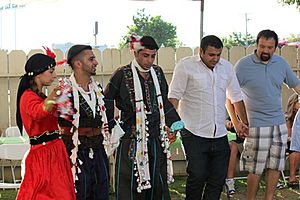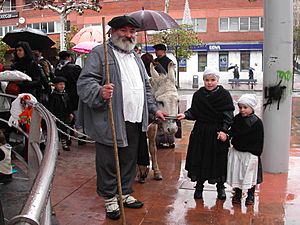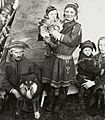Ethnic group facts for kids
An ethnic group is a group of people who share a common background. They might have the same ancestors, speak the same language, or follow the same religion. These groups often live in the same area or nearby.
Sometimes, most people in a country belong to one ethnic group. But often, a country can have many different ethnic groups. Also, people from one ethnic group might live in several different countries.
Important international rules, like the International Covenant on Civil and Political Rights, protect the rights of ethnic groups. They also make sure these groups can use their own language.
Contents
Examples of Ethnic Groups Around the World
Ethnic Groups in Africa
Africa is home to hundreds of ethnic groups. Each group usually has its own unique language or dialect, and a special culture.
Many African ethnic groups are larger than just a small tribe. Some of these groups came from powerful kingdoms in the past. For example, the Akan group grew from the Bonoman kingdom (around the 11th century) and later the Kingdom of Ashanti (in the 17th century).
Ethnic Groups in Asia

Asia has a huge number of different ethnic groups. These groups have learned to live in many different climates, from very cold Arctic areas to hot tropical zones. They have also adapted to mountains, deserts, grasslands, and forests.
Along Asia's coasts, ethnic groups have found different ways to get food and travel. Some groups are mainly hunter-gatherers, meaning they find their food in nature. Others practice transhumance, which is a nomadic lifestyle where they move their animals to different pastures. Many groups have been farmers for thousands of years. Today, some groups live in big cities, like in Hong Kong, Shanghai, and Singapore. Most of Asia gained independence from colonial rule in the 20th century.
Ethnic Groups in Europe

Europe also has many ethnic groups. Experts say there are 87 different "peoples of Europe." About 33 of these groups form the main population in at least one country. The other 54 groups are ethnic minorities in every country they live in. However, they might be the majority in smaller regions within a country. About 105 million people in Europe belong to national minority groups. This is about 14% of all Europeans.
Some European countries, like France and Switzerland, do not collect information about the ethnicity of their residents.
Russia has over 185 recognized ethnic groups. The largest group is the ethnic Russian majority, making up about 80% of the population. The next largest group is the Tatars, at 3.8%. Many smaller groups live in the Asian part of Russia, like the Indigenous peoples of Siberia.
The Roma, sometimes called Gypsies, are an example of a largely nomadic ethnic group in Europe. They originally came from India and speak the Romani language.
Images for kids
-
A group of ethnic Bengalis in Dhaka, Bangladesh. The Bengalis are the third-largest ethnic group in the world, after the Han Chinese and Arabs.
-
The Javanese people of Indonesia are the largest Austronesian ethnic group.
-
This old picture from 1904 shows the many different ethnic groups in Asia.
-
A Sámi family in Lapland, Finland, in 1936.
-
The Irish are an ethnic group from Ireland. About 70–80 million people worldwide say they have Irish ancestors.
See also
 In Spanish: Etnia para niños
In Spanish: Etnia para niños






